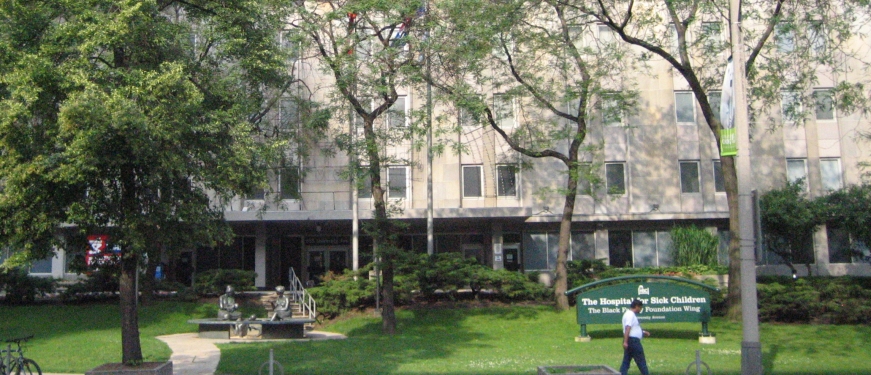- Hospital for Sick Children
Infobox Hospital
Name = Hospital for Sick Children
Org/Group =

Caption = The Hospital for Sick Children from University Avenue.
Size = 300px
Location =
Region = Toronto
State = Ontario
Country = Canada
HealthCare = Medicare
Type = Teaching, Specialist
Speciality =Children's Hospital
Standards =
Emergency = Yes
Affiliation=University of Toronto
Beds = 265
Founded = 1875
Closed =
Website = http://www.sickkids.ca/
Wiki-Links = |The Hospital for Sick Children, also known as SickKids, is a world-renownedchildren's hospital inToronto ,Ontario ,Canada . It is a teaching hospital affiliated with theUniversity of Toronto , and it is home to the world's second largest hospital-based paediatric research facility. It was founded in 1875, inspired by the example ofGreat Ormond Street Hospital inLondon ,England . The hospital is located on University Avenue in the city'sDiscovery District , a block south of Queen's Park near Queen's Park and St. Patrick subway stations.Funding
Medical treatments at SickKids are covered by publicly funded health insurance, as is the case in all Canadian hospitals. Philanthropy is a critical source of funding for SickKids that is separate and distinct from government and granting agencies. In 2006/07, financial support from SickKids Foundation to the hospital totalled $72.1 million. The support went towards infrastructure and support for physicians, researchers and scientists who compete for national and international research grants. Next to government, SickKids Foundation is the largest funding agency in child health research, education and care in Canada. The Foundation maintains a fund, called the "Herbie Fund", for patients not covered by Canadian health insurance. The fund was established in 1979 to provide for the treatment of a seven month old patient from
Brooklyn, New York named Herbie Quinones.History
accessdate=2006-09-14]
In 1876 the hospital moved to larger facilities. In 1891 the hospital moved from rented premises to a building constructed for it at College and Elizabeth streets where it would remain for sixty years. This old building, known as the
Victoria Hospital for Sick Children is now the Toronto area headquarters ofCanadian Blood Services . In 1951 the hospital moved to its present University Avenue location. The hospital underwent its last major expansion in1993 with the construction of a glass-roofed atrium on the east side of the main building.Infant deaths
In 1981, tests indicated that as many as 43 babies in the cardiac ward were poisoned by deliberate administration of massive overdoses of the drug
digoxin . This prompted an investigation by the Toronto police.Susan Nelles , a nurse scheduled on duty at the time of several of the deaths, was arrested and charged with first degree murder of four of the babies and she was on duty when 23 suspicious deaths occurred. During the same time frame Nelles was alleged to have murdered four babies, a total of 24 babies had died on the cardiac ward in suspiciously similar circumstances, but when she was not on duty. The digoxin deaths stopped after Nelles was arrested, but stricter policies on administrating drugs in the ward were also put in place. Charges against Nelles were thrown out at a preliminary hearing after it was revealed that she was not on duty when one of the four babies died. ARoyal Commission , the Grange Inquiry, on the deaths concluded at least eight infants had been murdered and suspicion fell on another nurse. As of 2005, only Nelles was charged with a crime involving the baby deaths. [Ontario. Report of the Royal Commission of Inquiry into Certain Deaths at the Hospital for Sick Children and Related Matters . Toronto: Ontario Ministry of the Attorney General, 1984. (Commissioner: Samuel G. M. Grange). ISBN 0774399686 (pbk.) ]A book on the case, "Death Shift: The Digoxin Murders at Sick Kids" was written by Ted Bessland.
Contributions to medicine
The hospital was an early leader in the fields of
food safety andnutrition . In 1908 aPasteurization facility for milk was established at the hospital. Researchers at the hospital invented the infant cereal,Pablum . The research that led to the discovery ofInsulin took place nearby at theUniversity of Toronto and was soon applied at the hospital. DoctorFrederick Banting , one of the researchers, had served his internship at SickKids and went on to become an attending physician there.In 1991, DrArlette Lefebvre foundedAbility Online , an online community for ill and disabled children and their families.Recent events
In 2004, doctors at SickKids helped save the life of 10-year-old Djamshid Popal from
Afghanistan by treating his heart problem, after theChildren's Hospital of Eastern Ontario diagnosed his illness and referred this patient.cite web|url=http://www.ctv.ca/servlet/ArticleNews/story/CTVNews/1101509587169_96918787/?hub=TopStories|title=Healthy Djamshid Popal heads home to Afghanistan|publisher=CTV|date=2004-11-27 |accessdate=2006-09-14]References
cite book
last = Braithwaite
first = Max
authorlink =
coauthors =
year =1974
title = Sick Kids; the story of the Hospital for Sick Children in Toronto
publisher = McClelland and Stewart
location = Toronto
id = ISBN 0-7710-1636-0Footnotes
External links
* [http://www.sickkids.ca/ Hospital for Sick Children official website]
* [http://www.sickkidsfoundation.com/ SickKids Foundation website]
Wikimedia Foundation. 2010.
